Energy recovery ventilators (ERVs) help improve IAQ and reduce energy consumption, and HVAC contractors and consumers have taken notice. ERVs are among the fastest growing segments of improved IAQ management in buildings, according to a report from Navigant Research. According to the report, worldwide revenue from ERVs will grow from $1.6 billion in 2014 to $2.8 billion in 2020.
A HIGH-END OPTION
Carter Stanfield, director of the air conditioning technology department at Athens Technical College in Athens, Georgia, and author of “Fundamentals of HVAC/R,” said that ERVs — and heat-recovery ventilators (HRVs) – are primarily sold in new installations and upscale homes in Athens.
“These homes often have foamed-in attics, Tyvek-wrapped walls, and sealed penetrations — in short, they don’t leak very much,” Stanfield said. “ERVs and HRVs reduce the energy hit from introducing outside air. They also make introducing outside air more controllable since the system is expelling air as well as introducing air. If a box is completely sealed, just cutting a hole in it does not let much air in, because some of what is already in the box must leave.”
ERVs, which transfer moisture as well as temperature, are better suited for muggy areas with high latent cooling loads, Stanfield noted.
“In colder climates, both HRVs and ERVs can freeze during winter operation, so ERVs are usually not installed where they will endure long operating hours below freezing because they can hold moisture in the heat exchanger core. Many HRVs have defrost cycles to address operation in cold weather. Even though they don’t transfer moisture, if you pass warm, moist air from inside over a heat exchanger that has sub-freezing air from outside passing through it, some of the moisture will freeze.”
A TOUGH SELL
HRVs aren’t a great fit in hot, humid climates, which is where Irving, Texas-based Tempo Mechanical does most of its business. However, the company does recommend ERVs in its energy consulting business as well as its HVAC new construction and energy retrofit business, according to Steve Saunders, CEO.
“In most cases, we really don’t find a lot of uptake on ERVs,” Saunders said. “There are a couple of reasons for that. In single-family residences, we find ERVs in the retrofit mode are pretty expensive. They come in a range of product offerings from $600 to $1,500, but that’s just the product cost. When you add installation, labor, and contractor markup, you find the installation price for a homeowner retrofit ERV is anywhere from $1,500 to $2,500.
“Most ERVs are being installed in high-end, custom homes,” he continued. “And that’s where the high-end homebuilders have large budgets and mostly tell people this is what you get and this is what it costs. These homeowners typically respond, ‘OK, I’ll take that.’”
Last year, Tempo installed about 6,000 HVAC systems collectively between its new construction and service/replacement business, and, of those, only three ERVs were installed, Saunders said. “All three were done in one house. Those [ERV] systems were requested by a homeowner who had moved to the South and had ERVs in his previous home. We asked him if he was sure, and he said yes, so we put them in. We have not found $2,500 as an installation cost to be a great price point for people who just have to have these in their homes. Part of that is because all of us in the industry have not done a great job communicating the importance and value of fresh air. But, it’s also a pretty big-ticket item. If you’re a consumer in today’s world, you have to choose how you’re going to spend your money.”
Ultimately, Saunders said his job is to help people invest their money wisely. His company recommends a different product, QuFresh by Air King, which Tempo actually helped design. QuFresh offers a mechanical ventilation solution that helps with humidity and temperature.
“Essentially, it’s a supply-only independent fan that delivers fresh air to the home in a constant, non-intermittent fashion,” Saunders said. “And, in that sense, it’s like an ERV and a HRV in that it’s a constant fan. The difference is, instead of having a heat exchanger, it has temperature and humidity sensors. When it gets too hot or too humid, it just shuts off the fan. You get all the fresh air you want when the conditions outside are acceptable, and it shuts off the fresh air when you don’t want it.”
Maintenance is an issue Saunders worries about on ERV and HRV systems.
“If homeowners are not buying an ongoing maintenance contract, then they’re not changing the filters that protect the heat exchangers, and I worry these filters are going to get clogged up and the homeowner will lose most of the value of the ERV.”
OVERCOMING COST OBJECTIONS
The fact that ERVs are mostly considered upscale items is an unfortunate stigma attached to the product, said Brett Nejmanowski, president of JT Dunn Heating & Cooling in St. Louis. Nejmanowski believes ERVs are a necessity for homeowners purchasing super-tight homes. The problem is getting the homeowner to see it that way.
“We just start talking IAQ,” he said. “We know they called us for heating and cooling, but we aim to talk about air quality first, because that’s what’s most important. We can get this place comfortable with the furnace and air conditioning, but we want to make sure the air we’re heating and cooling is healthy to breathe. We have to look at the entire climate in the house, and, ultimately, the environment. We’re indoor environmental specialists, and we bring the focus to the other side of heating and cooling, and that’s IAQ.”
The goal is to get the customer to start thinking about IAQ, which is something many of them may not be aware of.
“Not every customer is going to buy into it,” Nejmanowski said. “Some of them just want the lowest price. But, I’d say, 75 percent of customers out there are going to listen. Now, this conversation doesn’t necessarily come up in every home, because if the home is already really loose, then they don’t need an ERV. But, if the tightening conversation comes up, then we have to consider talking not just about heating and cooling, but climate control, as well.”
JT Dunn Heating & Cooling installs about 50 whole-home ventilation systems a year, which is more than the average contractor, according to Nejmanowski. “We should be selling a lot more,” he said.
One technique the company uses is showing homeowners the results from a blower door test. Seeing the evidence increases the chances of selling an ERV, Nejmanowski said.
“They can be rather expensive, but we put a price out there, and we stand by it. We’re not price-sensitive because our price is fair. If they purchase an entire system, we’ll wiggle some of the cost of the ERV down, simply because they’re buying so much from us already. But, you’re not always going to be able to overcome the price objection.
“We’re selling health and comfort,” he continued. “I look people in the eyes and tell them I know for a fact the product I’m selling will greatly benefit them. If you’re really sincere and believe in what you’re selling, people will see that. Consumers are faced with people selling them junk on a regular basis. We’re not one of those pushy salespeople trying to sell you snake oil.”
In order to help employees train others on ERVs and increase sales, Nejmanowski has an ERV set up in the the company’s office. Additionally, customers can visit the company’s office to see how the product works, if they choose. Nejmanowski has sold several HVAC systems the same way, so while he has not yet sold an ERV that way, he anticipates it happening soon.
“If people are willing to pay $20,000 for granite countertops, what’s another $1,500 for an ERV?”
Publication date: 4/18/2016
Want more HVAC industry news and information? Join The NEWS on Facebook, Twitter, and LinkedIn today!








